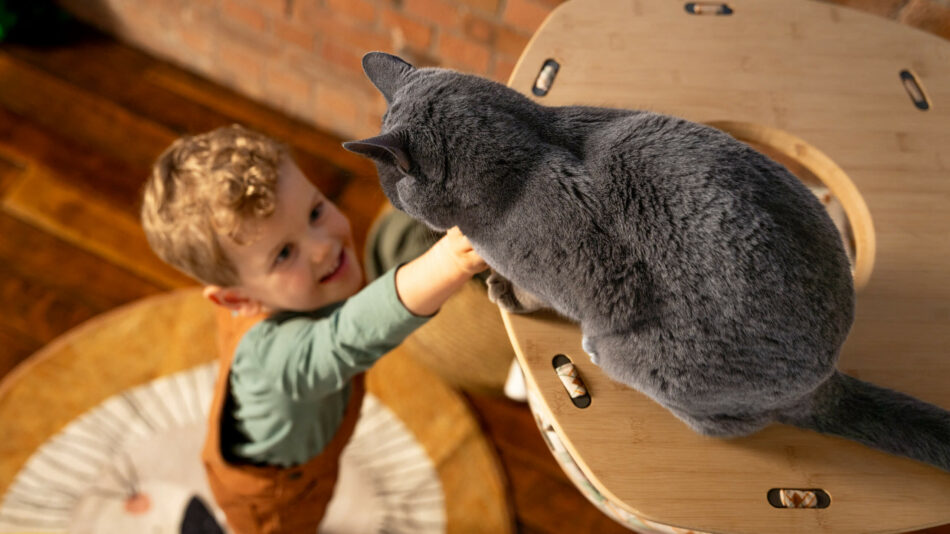Indoor and outdoor cat safety guide
Cats are enigmatic pets, and part of their allure is their curiosity and independence. But these personality traits can bring some challenges for their owners. In this indoor and outdoor cat safety guide, we’ll cover toxic plants, outdoor safety, and other essentials to help your feline live life to the fullest.
Safety struggles for cat owners
As any cat owner can attest: cats are curious by nature. And with this insatiable curiosity comes some head-scratching and adjusting on the part of their owners. Cats will readily nibble, swat, grab, or hunt anything that piques their interest. And as their owner, it’s your job to help keep them out of harm’s way. Here’s how to make your home feline-friendly — inside and out.
Indoor cat safety
While cats that are housed indoors are generally safer than those that spend all their time outside, there are still things in your home that can be potentially problematic. Here’s a list of common household items that can pose a risk to cats:
- Power cords
- Curtains or blinds
- String or rubber bands (if ingested)
- Button batteries
- Small toys or objects that can be swallowed
- Household cleaners
- Open flames (like candles or fireplaces)
- Certain essential oils
- Open windows (especially without screens)
- Mouse traps or bait
- Pesticides
Provide plenty of enrichment for your cat to play with to help deter them from getting into mischief. Indoor cat trees and cat scratchers are excellent, safe options for your feline to sink their claws into.
Toxic indoor plants
In addition to household items, there are several common indoor plants that are toxic to cats if ingested. These include:
- Lilies (extremely toxic, even in small amounts)
- Pothos
- Philodendron
- Aloe Vera
- Snake plant
- Sago palm
Choose safer varieties of house plants like spider plants, parlor palms, or Boston ferns. Artificial plants are a good substitute for their real counterparts, just be sure that your cat doesn’t chew on the faux foliage.
Outdoor cat safety
Cats that spend the majority of their time outside face more dangers than those kept indoors. The safest way to let your cat outside is to provide them with a fully-enclosed catio which allows them the freedom to roam while keeping them close to home. By keeping them in a designated safe area, you can avoid your cat coming into contact with common outdoor hazards, like:
- Antifreeze
- Fertilizer or lawn treatments
- Pesticides
- Predators (dogs in particular)
- Moving vehicles
- Extreme temperatures or weather conditions
It’s always safest for cats that spend time outdoors to do so in a fully enclosed area, or while under the supervision of their owners. Catio covers will help keep the sun and rain off of your cat while they play outside, keeping them shielded from the worst of the weather.
Toxic outdoor plants
Make sure your cat doesn’t have access to any areas that contain toxic plants. Common garden and landscaping plants that are toxic to cats include:
- Azaleas
- Rhododendrons
- Foxglove
- Oleander
- Tulips
- Daffodils
Always check a reliable source, like the ASPCA Toxic & Non-Toxic Plant List, before adding plants to your yard or garden.
Smart safety tactics for all cats
Whether your cat spends their time indoors or outdoors (or both), there are smart ways to keep them safe. A veterinarian is an indispensable ally as a cat-owner, and can provide these smart, life extending — and sometimes life-saving — safety measures:
- Spaying or neutering. This not only offers long-term health benefits, but also keeps cats closer to home by reducing their urge to roam. Spaying and neutering also diminishes marking and other hormone-driven behaviors, and prevents accidental litters.
- Microchipping. Essentially a permanent ID tag, a microchip (about the size of a grain of rice) is inserted by a veterinarian under the skin between your cat’s shoulder blades. If your cat gets lost, a veterinarian or shelter can scan for their microchip and get your contact information.
- Vaccinations and parasite prevention. These are especially important for cats that go outside, but all cats can be protected from preventable diseases by being vaccinated. Cats can also contract intestinal parasites and even heartworms along with fleas and ticks, so parasite prevention is also important.
It’s also a good idea to have a 24-hour emergency veterinary clinic’s number on hand for incidents that occur after-hours. If your cat is microchipped, be sure to keep any subscriptions or contact information up to date to ensure you can be notified if your cat is found.
Pet insurance may also be an option for your cat. Depending on the policy, their routine care and preventatives may be covered, along with a certain amount toward unexpected veterinary bills. Ask your veterinarian’s office about plans or companies they recommend.
Omlet and your cat
Every cat is unique, but their needs remain the same: an environment tailored to their nature. At Omlet, we believe in supporting their nature while providing you with easy to clean products that look great in your home. From our stylish Switch Cat Scratcher and customizable Indoor Cat Tree, to our safe and spacious Catio, our cat products are designed to delight owners and felines alike.
This entry was posted in Cats


